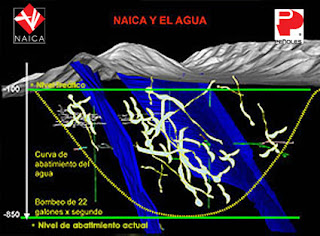These magnificiant caves were discovered on accident by miners draining the mones to extract minerals. The process revealed a natural phenomenon unknown to mankind. The formation of macro crystals is related to the relatively unknown geological conditions existing in the mine. They were formed under water in an area where sulphide saturated phreatic thermal waters (52 degrees C) came in contact with oxygen-rich cold waters that have naturally infiltrated from the outside. Essentially, these two waters could not mix thus creating the gigantic crystal gypsum deposits that we see today. It took thousands and thousands of years for this process to occur.
http://www.naica.com.mx/english/internas/interna2_1.htm
The sedimentary rock known as Limestone, which is mainly composed of calcium carbonate in the form of the mineral calcite. The Naica mines are comprised mostly Limestone that is formed from and near shallow, warm bodies of water where biological debris such as organism waste, shells, and fossils. Most of the Limestone-forming environments are found between 30 degrees north latitude and 30 degrees south latitude. Making the Gulf of Mexico prime real estate for these wonderous caves. Evaporation processes are also a contributing factors by in where droplets of water drain through the cracks and fissures in the surface creating the stalactites.
The mine of Naica is in a semi desertic region about 100 kilometers southeast of the city of Chihuahua. The area is crossed by a series of low ridges. The mine opens on the northern side of one such ridge, the Sierra de Naica. It is an anticline, outcropping from a wide alluvial plain, and composed of carbonate forma- tions 12 kilometers long and 7 kilometers wide. Intrusive magmatic activity, which affected this part of the North American subcontinent, occurred between 25 and 26 million years ago. Recent coring, by the mine owner revealed an igneous body about 1,140 meters deep. The whole mining area sits on top of this magma body that heats the groundwater: water flowing into the mining galleries has a temperature close to 127 degrees. There is little risk of eruption from the chambers.
SOURCES: http://www.slideshare.net/random13579/naica-crystal-cave
http://news.nationalgeographic.com/news/2007/04/photogalleries/giant-crystals-cave/
http://www.stormchaser.ca/caves/naica/naica.html

